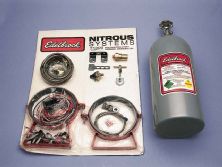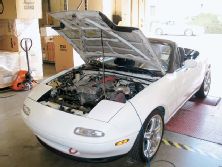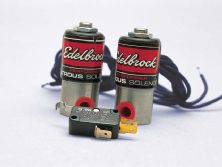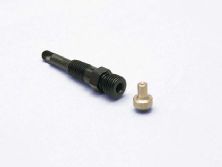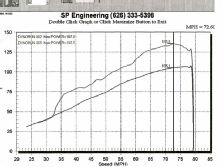It doesn't matter what you're buying, everyone is out to get the best deal possible. No one likes getting ripped off. This is true when it comes to performance upgrades for your car. Everyone wants the most power for the fewest dollars spent. With that said, adding a bolt-on nitrous kit is the easiest way to dramatically increase the output of your ride without breaking the bank.
The Edelbrock Performer EFI system retails for less than $400 but packs a mighty power punch. The kit comes with all the necessary components for a complete installation. Although the media has portrayed nitrous systems as extremely dangerous and volatile, a properly installed nitrous system is quite safe and reliable.
One feature the Edelbrock kit utilizes is a fuel pressure safety switch, which turns off the nitrous system if fuel pressure drops below a preset level. Another safety device utilized is a WOT (Wide Open Throttle) micro-switch that ensures nitrous is only injected at WOT for proper fuel enrichment.
We put the Edelbrock Performer EFI nitrous kit to the test. After carefully reading the instructions (ha, like we read instructions) we installed the Edelbrock single-nozzle dry-manifold system into a 1991 Mazda Miata.
We started from the back of the Mazda, mounting the bottle in the trunk compartment with the supplied brackets for the bottle. To use the nitrous most efficiently, it's imperative you mount it facing the front of the car so the pickup in the bottle faces the lowest point.
The next step was to run the nitrous line from the trunk to the engine compartment, where the nitrous solenoids would sit. We went to Home Depot and purchased some electrical clamps to hold the nitrous line in place, or you can use the zip-ties Edelbrock includes with the kit.
After assembling the two nitrous solenoids onto the supplied bracket, we found a home for the solenoids next to the windshield water reservoir. Edelbrock recommends you mount the nitrous nozzle at least 6 inches from the throttle body for proper nitrous distribution to all the cylinders. Fortunately for us, the factory intake pipe was constructed from ABS plastic, so drilling the piece was easy.
After installing the proper nitrous and fuel jets for a 50-shot, we wired the system. Edelbrock provides a well-drawn schematic of where all the wires need to go; you don't have to be an electrician to wire the system.
Once the wires were connected, we tested the solenoids, making sure both were operating when the throttle body was engaged in its WOT position. Be sure to test the solenoids with the nitrous bottle closed. Once installed, it was off to the dyno.
Our Miata was already slightly modified with a Brainstorm 4-to-1 header, Brainstorm exhaust and Racing Beat intake. And the car had more than 190,000 miles on the odometer. The Mazda baselined at 107.8 hp to the rear wheels without nitrous.
With the laughing gas, the 50-shot Edelbrock system boosted the output to 135.5 hp, an increase of 27.7 hp. At 6400 rpm we witnessed an increase from 105.1 hp to 135.5 hp, a 30-plus hp bump. The kit can be easily manipulated for more power by increasing the nitrous jet's size, but we felt the Miata didn't need more power.
What better way to increase the power output of your car by 30 hp to the wheels for less than $400? Remember, our 30-shot is conservative jetting; there is more power in the kit if your fuel system can handle it.
One of the beauties of a nitrous system is it can be added to any vehicle. If you have a Pinto or a brand-new Civic, a nitrous kit can easily bump the power output of your ride in a couple of hours.

